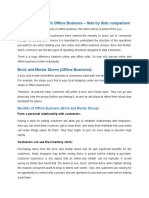0% found this document useful (0 votes)
183 views2 pagesE Com Vs B&M
E-commerce refers to the process of buying and selling goods electronically, typically over the internet. This allows for remote ordering and delivery of products to customers. Brick-and-mortar businesses have physical store locations where customers can visit to browse products and complete purchases in-person. While e-commerce operations do not require a physical presence, more brick-and-mortar businesses are adopting online platforms to create an omnichannel shopping experience. Key differences between the models include their accepted payment methods, preferred advertising approaches, and abilities to provide personalized customer service.
Uploaded by
DivyaCopyright
© © All Rights Reserved
We take content rights seriously. If you suspect this is your content, claim it here.
Available Formats
Download as DOCX, PDF, TXT or read online on Scribd
0% found this document useful (0 votes)
183 views2 pagesE Com Vs B&M
E-commerce refers to the process of buying and selling goods electronically, typically over the internet. This allows for remote ordering and delivery of products to customers. Brick-and-mortar businesses have physical store locations where customers can visit to browse products and complete purchases in-person. While e-commerce operations do not require a physical presence, more brick-and-mortar businesses are adopting online platforms to create an omnichannel shopping experience. Key differences between the models include their accepted payment methods, preferred advertising approaches, and abilities to provide personalized customer service.
Uploaded by
DivyaCopyright
© © All Rights Reserved
We take content rights seriously. If you suspect this is your content, claim it here.
Available Formats
Download as DOCX, PDF, TXT or read online on Scribd
/ 2



























































































